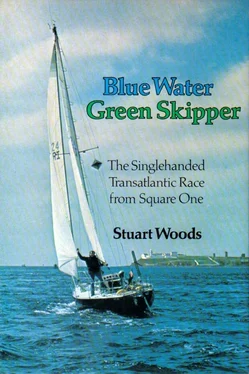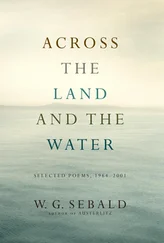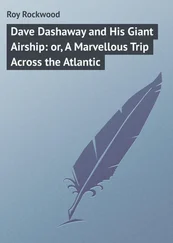The sail plan we worked out for my boat was made up of a mainsail, a large genoa (foresail), a number-two genoa (slightly smaller than the large one), a medium-weight spinnaker for all-round use, a floater spinnaker for very light winds, and a smaller “starcut” spinnaker for reaching and for running in heavy winds. (Later we dropped the starcut, because I realized I wasn’t about to set a spinnaker, single-handed, in strong winds.) There would be no smaller headsail than the number-two genoa, because I intended to reef that sail rather than change down to a smaller one. This would be done by virtue of a device called a Dynafurl. It works this way: the sail, instead of being set on an ordinary wire forestay, is set on a grooved, solid rod forestay, called a Twinstay. In ordinary, crewed racing, a sail can be set on this stay while another one is still drawing, giving an advantage over conventional sail changing. The Dynafurl consists of two swivels, one at the top of the stay and one at the bottom. When reefing the sail, a rope is pulled and the sail wraps itself tightly around the forestay, displaying progressively smaller area. It can be reefed right down to storm jib size in this fashion.
My reason for choosing this system was twofold: (1) I reasoned that in a 3,000-mile race, an awful lot of time could be spent changing sails in changeable conditions, and the boat would be slowed during sail changes; (2) If the only sail change I had to make was from the number-one genoa to the number-two genoa, this would keep me off the foredeck in heavy weather, when it can be a very dangerous place. My only sail change would be made in less than fifteen knots of wind.
The mainsail, instead of having roller reefing, where the sail is rolled up around the boom, would have slab reefing, in which the sail is simply tied to the boom by a row of cringles (eyes) sewn across the sail. This would be faster single-handed, and the sail would set better as well.
Later, we would add two other sails to the wardrobe: one, a duplicate number-two genoa, so that twin headsails could be set when running in fresher winds, and so that I would have a spare for my principal working sail. Twin headsails are easier to control than a spinnaker and have self-steering properties, too, which would be a help in strong winds. The other addition would be a drifter, or very light large genoa, made of nylon. This would help considerably when beating or reaching in very light winds. Much later, the need for a storm jib would present itself, but I’ll get to that later.
With the sails ordered and a delivery date promised to coincide with the boat’s launching, I set about selecting other gear. I chose the well-known Hasler Windvane self-steering system. I must admit I chose it with a minimum of research. Mike Ellison, of the Amateur Yacht Research Society, which had done much research, recommended it, and so did Ron Holland. The difficult decision to make was whether to order the small or medium size of the unit. My boat fell in a gray area where the small unit might be big enough and might not. But the larger unit was twice as heavy and twice as expensive, so I took the chance and went for the smaller one. I would not know until the boat was launched whether I had made the right decision, and I was plagued by doubt.
I chose the Avon four-man life raft and the Avon Redcrest inflatable dinghy as my tender. Both were well proven, and I had been impressed by Avon quality at the London Boat Show. Life raft stowage was going to be a problem, because even a four-man raft is rather bulky, and no place had been designed into the Shamrock for it, a mistake, I felt, and one which I communicated to Ron on more than one occasion. I chose Brookes & Gatehouse electronic instruments, simply because, from everything I could gather from every source I could find, they were considered to be the finest in the world. I ordered their Hornet unit, which combines, in one control box, wind speed, wind direction, magnified wind direction (a fine display for beating to windward), water speed, and distance covered. To this I added the Hound water speed amplifier, which gives a finer display of small changes in speed and is invaluable for fine sail trimming.
I also, after much soul searching, ordered the B&G Horatio unit, which offers several functions. Once a course is set into an electronic compass on the deckhead, steering can be done by keeping a needle on a dial straight up, instead of steering a compass course, which demands more concentration and is more tiring. The unit also has an off-course alarm, which can be set for either twenty or forty degrees, important when the boat is under self-steering and will change direction automatically if the wind direction changes. Finally, there is a constant digital readout of the number of miles sailed to either port or starboard of a set course. This would be valuable when setting a course when about to go to sleep. On awaking, I would know how far off course I might have sailed. Horatio was an expensive piece of equipment, costing as much as the complete Hound, but I felt I might genuinely need it.
I also chose the B&G Homer/Heron radio receiver and radio direction finding compass, and the shortwave converter for the radio, which would enable me to pick up radio time signals at sea.
To the Brookes & Gatehouse equipment I added the ubiquitous Seafarer depth sounder (at the suggestion of B&G, because I wanted to economize) and the Seavoice VHF, already mentioned, made by the same company. (I later exchanged the self-contained model for the ordinary model, because I was having difficulty finding room for the extra bulk of the first unit.)
Finally, I added, as a backup radio receiver, the American Zenith Trans-Oceanic Portable, probably the best of its kind, and a Philips car stereo radio/tape player, purely for entertainment. At home I am never without music playing, and I would have missed this terribly at sea.
That was a lot of electronic and electrical gear, but it all got used. I have always had a thing about being well equipped, and the boat would be evidence to this part of my character. In defense, I must say that I felt my lack of experience made electronic help all the more important. A lifelong sailor might guess at the wind speed or direction accurately, but I could not. I felt I needed all the help I could get. This feeling, it turned out, was entirely correct.
I had to choose an engine as well. The choice was between the Yanmar 12 and the Farymann 12 diesels, the Farymann having hydraulic drive. The Yanmar has a good reputation, and I was offered a nice discount on it, but I chose the Farymann because of its compact size and the versatility of installation of the Hydromarine Hydraulic Drive. This equipment is manufactured in Ireland, and Hydromarine offered me, at no extra cost, a heavy-duty unit more suitable for running for long periods without a load, as when charging batteries. They were later to give unstintingly of technical help and advice.
On March 27, Laurel Carlin Holland gave birth to a daughter, Kelly, much to the astonishment of everyone, since triplets, at a minimum, had been expected. Ron was completely bemused by the idea of being a father, and we had a celebratory dinner at Ballymaloe.
My social situation took a turn for the better when a letter came from Ann O’Donahue, a London friend, in response to an invitation issued in January. She would be arriving in early April for a visit. I was looking forward to that. The only people I knew in Cork were my designer, sailmaker, and boatbuilder, none of them very pretty.
Ann arrived on Monday afternoon and we renewed our acquaintance over dinner at Arbutus Lodge, Cork’s best restaurant and, many think, Ireland’s. Having Ann about the place made an enormous difference. We had the Hollands and Barry and Mary Burke over for dinner and, confirming conversations we had been having, Barry promised to mold my boat next, making it number seven instead of ten. She would be launched, said Barry, around June 1. This was an enormous relief to me. The red boat was only now being completed, and I had been increasingly worried about having the boat ready for the Azores race. Now I would have a month more to sail her than planned!
Читать дальше












